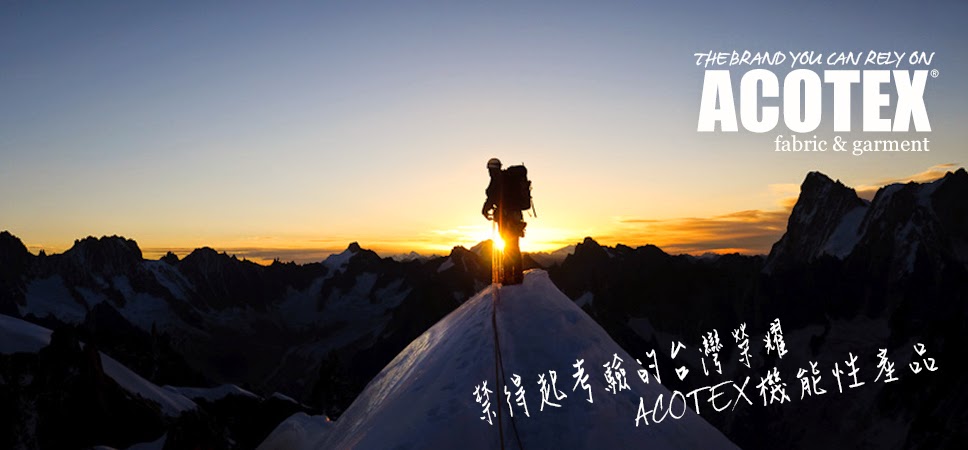
認識布料潑水(撥水)效果加工:
防水外套或風衣外套經常標榜著外層的「潑水」、「撥水」或「防潑水」,究竟哪一個說法才是正確呢?以效果來看,布料就像可以將水撥開似,所以專業的說法應是「撥水」而非「潑水」。但因為時下市面上都已經慣用「潑水」,所以在這就以大家慣用的「潑水」作為主要。而如果布料同時又具有「防水」與「潑水」效果時,有時會簡稱為「防潑水」,即是又防水又潑水的意思。潑水並非防水!了解其中原理
大部分的「潑水加工」是在布料在完成染整步驟後,再將布料通過浸泡通過疏水性化學溶劑,而這種「疏水性溶劑」也就是所謂的「潑水劑」,會在布料的纖維周圍形成一層看不見的保護層。有了這層保護層,可以讓布料短暫性的阻擋雨水,也不容易沾附髒汙,雨水在布料表面的時候形成水珠狀(類似荷葉上的露珠),水珠會直接滑過布料表層,而不是直接滲入纖維中,輕輕一撥,便可抖落雨水。但畢竟潑水效果並非防水,雨水在經過時間和壓力後還是會穿透布料。所以潑水效果和防水效果千萬不可以混為一談!所謂防潑水,其實是兩種功能。
※ 疏水性指的是分子與水會互相排斥的物理性質。
相關產品新聞: 澳洲防水T恤,再也不怕飲料打翻。
潑水效果並非永久性
在經過「潑水效果加工」處理之後,布料的潑水效果卻並非永久,其效果會因所使用的「潑水劑」品質而有所不一。使用一般的潑水劑的衣物,在經過幾次洗滌之後(約2~3次),其潑水效果即可能會降到微乎其微,或完全消失。但若使用的是「耐久性」的潑水劑加工處理即所謂的 DWR(Durable Water Repellent),衣物的潑水效果便可禁得住更多的洗滌次數(可達20次,甚至40次)。世界知名的美國杜邦 TEFLON® 防污保護即是耐久型的氟素化學品處理,不但具有潑水效果,還兼具潑油的效果。以下為TEFLON®紡織潑水劑的產品列表:
| 加工種類 | 產品名稱 | 適合布種 | 功用 / 備註 |
|---|---|---|---|
| TEFLON® 紡織潑水劑 |
OLEOPHOBOL SLA New OLEOPHOBOL CO OLEOPHOBOL 7752 |
長纖、混紡、棉 嫘縈、混紡 |
潑水潑油處理; TEFLON® Repel 吊牌 潑水潑油處理; TEFLON® Repel 吊牌 低溫潑水潑油加工; TEFLON®吊牌 |
| OLEOPHOBOL SRN New OLEOPHOBOL ZSR |
各種纖維 棉、混紡 |
易去污處理; TEFLON® Release 吊牌 易去污處理; TEFLON® Release吊牌 |
|
| OLEOPHOBOL SRM OLEOPHOBOL 7713 |
針對平織聚酯纖維 沙發窗簾等傢俱用布 |
吸濕易去污; TEFLON® Ultra Release 吊牌 高磨擦力的潑水潑油及易去污; TEFLON® Advanced Dual Action吊牌 |
 |
| 3M出產的布質防汙噴霧劑 |
就算是再耐用長效的潑水效果還是會隨著洗滌的次數而漸漸消失,所以當潑水衣物洗滌完後,是可以經由簡單的加工處理以保持或恢復其潑水效果的。在衣物溫和洗滌之後,噴上具有潑水效果的噴霧劑,等待藥劑乾了之後便大功告成。
潑水效果的測試方法
潑水效果可以分為5級,其測試標準一般在40度水溫洗滌5次後進行測試,潑水布料必須至少達到等級4以上(ISO)潑水度等級(亦即達到90分以上之潑水效果評分)。
潑水效果的耐久性可經由20、50次及100次的洗滌後測試得知。潑水效果布料適用於風衣外套、防水外套、運動服飾、雨傘、傢飾等。
目前台灣業界技術,初始潑水度可達100分,水洗100次後80分以上(測試方法為AATCC第22號測試法)。如以光學接觸角(Optical Contact Angle)測蓮葉(Lotus leaf)之接觸角為135°,一般潑水效果加工為130°,一般奈米超潑水效果加工,接觸角可達140°,如以特殊奈米技術作特殊機能性面料改質國外的技術,其接觸角甚至可達150°。
備註:
※ 潑水度等級為美國紡織化學師與印染師協會(American Association of Textile Chemists and Colorists,AATCC)訂定之標準。
※ 本標準規定潑水紡織品之評定及試驗法,適用於經潑水加工處理之紡織品;但不適用於測定其抗水滲透性。
防潑水判定分級 Performance specification:
等級 Grade
|
判定 Classification
|
100(ISO 5)
|
優 Excellent
|
90(ISO 4)
|
好 Very Good
|
80(ISO 3)
|
可 Good
|
70(ISO 2)
|
---
|
50(ISO 1)
|
---
|
0
|
---
|
Water Repellent Fabrics:

Older methods for factory application of DWR treatments involve applying a solution of a chemical onto the surface of the fabric by spraying or dipping. More recently the chemistry is applied in the vapor phase using Chemical Vapor Deposition (CVD) machinery. The advantages of CVD include: (1) It eliminates the use of hazardous and environmentally harmful solvents in the application process; (2) The process requires less chemical; (3) the waterproof layer is extremely thin and has less effect on the natural look and feel of the fabric. Later advances have eliminated perfluorinated acids, considered to be potentially hazardous to human health by the US Environmental Protection Agency,[2] from the application process.[citation needed]
Re-treating garments
Durable water-repellent finishes tend to wear off over time, and fabrics need to be re-treated to maintain water-repellency. Washing the garment first helps any DWR that remains to work better; a subsequent treatment with a 'spray-on' or 'soak-in' treatment will improve water-repellency.
The difference between waterproof and water repellent
Misunderstanding of the term water repellent can lead to disappointment when testing out a product, as you can find your feet or other parts become wet. For example, if a fabric or product is classified as 'repellent' this means it will repel water but is not impervious to it, or put in another way, there is a level of water pressure it can withstand before leaks start to appear. This is not seen as a disadvantage as the materials used will readily allow air to pass through removing the hot microclimate next to the foot, providing comfort and restricting sweating and discomfort.
Similarly to waterproof products there are criteria that fabrics and textiles have to undergo in order to test their repellency and protection levels and thus be given an overall rating. The Bundesmann test is one way of measuring this.
Test method for fabric repellency
Water repellent fabrics are processed with water repellent additives, so that water form droplet and stay on fabric surface but do not spread on fabric surface or penetrate the fabric – a phenomenon known as “the lotus effect.” The efficiency of water repellency is graded in 5 ratings. A standard test is usually performed after five home launderings with water at 40℃. To qualify as water repellent, the fabric must perform to at least rating 4 (ISO), in other words, 90 or better efficiency (AATCC). Further tests for the durability of water repellency may be performed after 20, 50 or 100 launderings at similar temperatures. Water Repellent Textiles are well-suited to the face fabrics of windbreakers or other outerwear as well as umbrella fabrics, furnishing fabrics…etc.
With current technology in Taiwan, the initial water repellency of Water Repellent Textiles reaches 100 ; having undergone 100 launderings, their water repellency still reaches 80 or above. The test method employed is AATCC 22. The Optical Contact Angle of lotus leaf is 135°; fabrics processed by regular water repellent treatments can have an Optical Contact Angle up to 130°; fabrics processed by regular “nano super water repellent” treatments can have an Optical Contact Angle up to 140°. However, if we utilize a unique nanotechnology for functional textiles to modify the surface texture of fabrics, we will be able to impart an Optical Contact Angle up to 150° to the fabrics and surpass the technical level of most foreign countries as far as water repellency is concerned.
編排整理 Edited: ACOTEX Fabric Talks 布料指南
部分資訊來源 Info Source: 台灣機能性紡織品、全球紡織資訊網、創馨貿易

哇!好專業!你們有出書嗎?!好想研究材質;沈富育洗衣達人的書我都有買了!不過現在的衣服很難判斷!
回覆刪除感謝您的支持!未來也將繼續努力分享更多專業知識。
回覆刪除